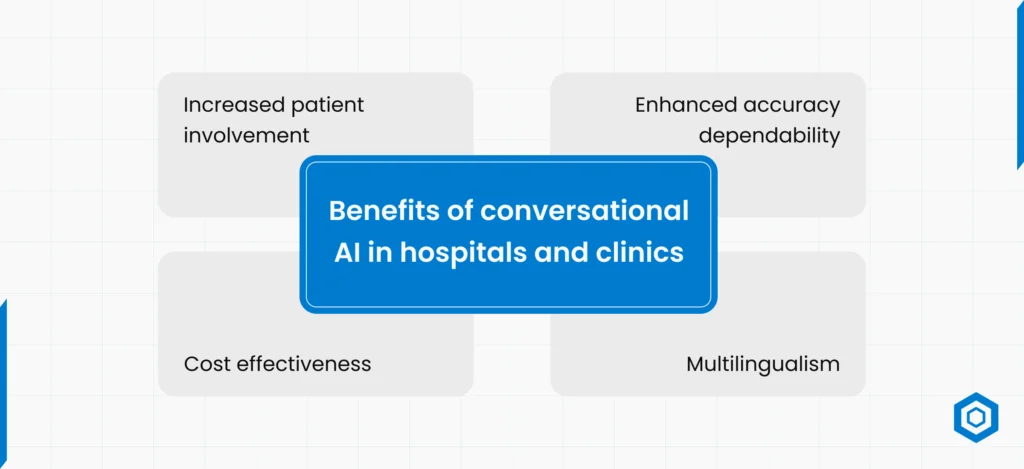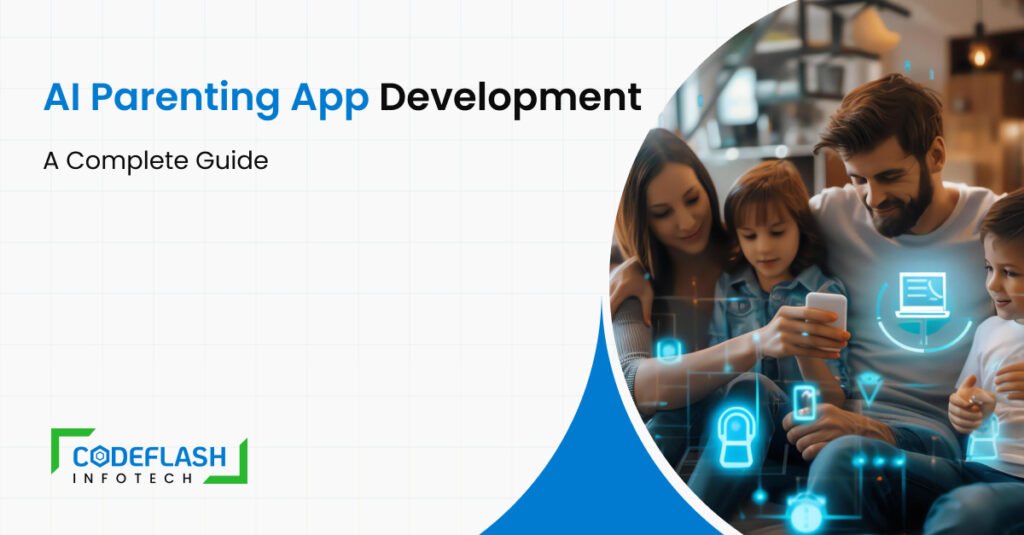
Conversational AI in Healthcare: How It Works, Benefits, and Use Cases
16 SEPTEMBER
The global healthcare industry is facing unprecedented challenges, including staff shortages and patients being unable to communicate effectively. While “conversational AI in healthcare” still faces specific challenges, it is rapidly evolving into a transformative solution.
Statista estimates that the global market for AI will be worth approximately $187 billion by 2030. Healthcare will also utilise AI consulting strategy more extensively. This change is primarily due to better real-time automation, natural language processing, and machine learning.
AI-powered virtual assistants make it easier for healthcare workers to perform their jobs and communicate with patients, which changes the way healthcare is delivered.
Healthcare chatbot solutions are being explored by startups, large hospital networks, and healthcare tech companies to enable staff to do more, provide better care, and respond more quickly. Talking AI is improving and simplifying everyone’s life. You can schedule appointments with patients or contact them by phone.
What is conversational AI in the medical industry?
AI technologies, such as speech recognition, machine learning, and NLP, enable patients and healthcare service providers to communicate with each other in a manner similar to how people do.
These new medical chatbot developments with NLP solutions surpass traditional rule-based chatbots by understanding medical jargon and user needs, enabling them to respond to patients in a manner that makes sense at the time.
This technology enables chatbots to deliver effective services on healthcare-related promotional platforms, mobile apps, and the Web.
The AI could be used as a companion, reminding people when to take their medicine, informing them about what to do when they are discharged from the hospital to manage their symptoms, or continuously monitoring their mental health.

Essential Elements of Healthcare Conversational AI
For conversational AI to work effectively in Healthcare, it requires certain critical technologies. They ensure that people receive the help they need quickly, safely, and without any trouble.
- Natural language processing
We provide advanced Natural Language Processing (NLP) solutions for healthcare, enabling systems to understand and respond to patient queries in real time. From delivering clear explanations of test results to offering guidance on medications and symptoms, our NLP-powered chatbots and virtual assistants enhance patient engagement, streamline communication, and make healthcare more accessible and easy to navigate.
- Machine Learning for Smarter Conversations
Machine learning makes conversational healthcare tools smarter with every interaction. By learning about patient behavior and communication patterns, healthcare providers can engage in more natural and personalized conversations, helping patients feel understood and making care easier for both them and their caregivers.
- ASR for Smarter Healthcare
Transform spoken words into accurate text with Automatic Speech Recognition. From telehealth platforms to hospital voice assistants, ASR makes healthcare simpler and more accessible—especially for seniors and patients with vision challenges.
- Text-to-Speech in AI
TTS enables AI systems to “talk back” in natural voices. It’s especially valuable for people with visual impairments or in situations where hands are busy, such as surgeons in the operating room. By allowing digital assistants to communicate with both humans and each other, TTS makes working alongside machines smoother and more intuitive.
- Contextual AI for Better Healthcare
Contextual AI in healthcare chatbots tracks what patients want to do and remembers their past actions. These AI-powered chatbots maintain accurate records of symptoms and treatments, giving healthcare providers a clear view of each patient’s health journey. By using contextual AI, doctors and caregivers deliver more personalized, consistent, and effective patient care.
- Making sure that medical record systems can talk to each other
When digital assistants can access electronic records, it’s easier to check on patients, share test results, send appointment reminders, and fill prescriptions. In other words, healthcare workers can spend more time with patients and less time completing paperwork
How conversational AI is transforming healthcare
People who work in Healthcare are already utilising AI that can talk to them. It’s being used to monitor patients currently under care and engage with new ones. Below are some practical ways chatbots are making a difference in real-world medical settings.
- Setting up appointments and sending reminders
People can make, change, or cancel appointments without having to wait for someone else to do so. Patients can easily set up appointments with their doctors by texting or calling them. It makes things easier, and fewer people don’t show up.
- Seek symptoms and establish a preliminary diagnosis
AI-powered tools collect basic health information and symptoms before a doctor’s visit. Based on the user’s input, these bots might suggest triage or possible diagnoses. It helps streamline emergency services and expedite the delivery of care.
- Keeping drugs safe
If AI can communicate with humans, it can remind them to take a pill and note when they should call again. It can also tell you some rudimentary information about how drugs interact and what side effects they have. This saves more people to their plans, and reduces the potential for negative health outcomes.
- What to Do After You Get Help
Chatbots can screen your health at home or after surgery. They schedule follow-up visits, track your progress, and give you health advice. These services are beneficial for patients and can help detect problems early.

Benefits of conversational AI in hospitals and clinics
Beyond being an automation tool for today’s healthcare practitioners, conversational AI is a strategic advantage. From enhancing communication with patients to alleviating the burden on healthcare staff, these AI systems are revolutionizing the delivery of care in clinics and hospitals.
1. Increased Patient Involvement
This AI can assist in personalized conversations during and after medical visits. They provide continuity of treatment responsibility and participation by patients through follow-up visits, medication reminders, and health advice. Patients feel more connected, supported, and valued on their care journey with regular communications.
2. Enhanced Accuracy and Dependability
While humans can offer comfort and explanations about these questions, virtual agents can only provide canned responses based on the medical protocols and training data upon which they are built. They remove the possibility of fatigue or misunderstanding that could cause errors, and when individuals are responding to the same questions over and over again. This way, patients hear advice that’s constantly updated and as accurate as possible.
3. Cost Effectiveness
Automated support, implemented with less dependency on human resources (who incur significant overhead costs), could save healthcare a substantial amount of money. AI systems can process hundreds of queries simultaneously, without requiring additional personnel. This cost-effectiveness at scale benefits both small clinics and large hospital chains.
4.Multilingualism
Conversational AI tools enable engagement with patients who would not otherwise be included in care, regardless of their linguistic background. This improves care for people who do not know the language, thereby raising the bar for them. Bots with multilingual capabilities offer unlimited access to health services for diverse communities, regardless of their differences.
Challenges to the acceptance of conversational AI in healthcare
But implementing conversational AI in healthcare isn’t without its downsides. To use it safely and effectively, they’ll have to overcome technical, operational, and ethical challenges. Providers need to be sensitive to statutory requirements and meet all relevant professional standards.
1. Understanding Context
Ambiguous, sentiment- and context-rich input AI for patient communication can be difficult for AI to comprehend. For example, making sense of it as “feeling heavy” would require a more clinical interpretation than simply processing.
2. Complexity of Integration
The technical challenges of integrating AI into an EHR platform and legacy hospital data are of profound complexity. There is often very little support for APIs or standardised data formats in most healthcare organisations. This can lead to operational frictions, cost overruns, delays, and other technical challenges that are typically encountered during the implementation phase.
3. Lack of Human Touch
Indeed, AI is effective, but it often lacks the genuine empathy or emotional intelligence necessary when dealing with sensitive topics, such as mental health or end-of-life support. Most people in distress or trauma who are also patients would rather have real people involved. Overuse or abuse of bots can dehumanize or isolate people.
4. Training and Monitoring Requirements
Conversational AI needs continuous training to learn new medical terminology, treatment blogs, and user interactions. In the absence of regular updates and performance evaluations, the chatbot may give wrong or irrelevant responses. Quality and safety can only be achieved through supervision and vigilance.

The Future of Conversational AI in Healthcare
Conversational AI has seen rapid advancements and will become increasingly valuable in the healthcare domain. The future will be much more about customisation, emotional intelligence, and compatibility.
1.Emotionally Intelligent Bots
Next-generation chatbots, utilizing emotional artificial intelligence and sentiment analysis, will gain a deeper understanding of people’s emotions. Patients will adjust their tone and verbal or written responses according to their emotional state or level of stress. This will help enhance the overall healthcare exchange as a caring, humanised process.
2. Voice First Assistants
Patients will be able to vocalise their queries instead of typing, solely due to voice-first artificial intelligence systems. Generative AI for healthcare supports elderly or disabled patients, allowing for the use of voice-activated (i.e., voice-first) bots in virtual clinics and home care settings.
3.Personalised Health Suggestions
The AI bots will serve as virtual health coaches, allowing you to feed them and analyse user data, including fitness, lifestyle, medical history, device-worn data, and other relevant index data.
That would be the app’s virtual care coaches, offering personalized guidance on eating, moving, and medication, custom-curated for each individual. These wearable or virtual therapeutics will help care for and manage chronic conditions.
4. Linking up with Wearable Technology
When associated with smartwatches and fitness tracking devices, AI bots can also retrieve real-time health statistics. It enables you to issue proactive recommendations, such as “Monitor vital sign data” or “Schedule a consult if there are any concerns,” as seen in the example above. Prophylactic medicine, then, is but one form of medical treatment.
5.Localised & Multilingual AI
Tomorrow’s healthcare chatbots will be spouting not only in multiple languages but also in multiple cultural languages. Oh, and better still (bring it home here), local AI will make the tone, phrase, and information relevant to your neck of the woods. This is particularly relevant for rural or international health outreach projects.
Conclusion
Conversational AI in Healthcare is more than just a technical chatbot development; it represents a significant step toward providing patients with faster, more intelligent, and simpler care.
AI chatbots and voice-activated virtual assistants can help hospitals and clinics reduce administrative burdens, streamline operations, and enhance patient communication. And the role of conversational AI is only going to become more prominent as pressure mounts for intelligent, 24/7 care.
We at Codeflash Infotech enable healthcare standardization to leverage the most from AI through our tailored healthcare chatbot, which integrates well with workflows and patient requirements. Our dedicated development team is here to help you do what’s important: from automating triages to deploying NLP-driven bots that deliver AI-assisted support.

Frequently Asked Questions
Healthcare chatbots and voice assistants can understand and respond to conversations like real people. They achieve this by memorizing language patterns. They help patients make appointments, ask questions, and prepare for diagnosis.
AI chatbots in healthcare are capable of a wide range of tasks, such as answering commonly asked questions, reminding patients, helping them recover, and sorting them.
They cited several advantages, including 24/7 patient access, improved triage and record-keeping, reduced administrative work, and, most importantly, happier patients who can speak with someone they know.
In the hands of reputable companies, these tools can also help keep patient data safe by complying with strict privacy regulations, such as HIPAA.
Table of Content
What is conversational AI in the medical industry?
Essential Elements of Healthcare Conversational AI
How conversational AI is transforming healthcare
Benefits of conversational AI in hospitals and clinics
Challenges to the acceptance of conversational AI in healthcare




